

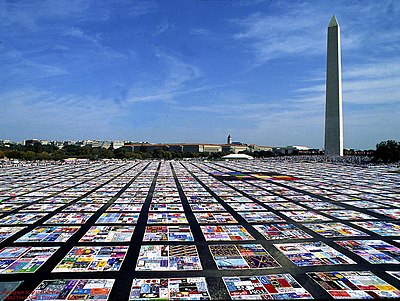



The History of the United States of America Part 9 (1980-1991)
Now, this era of time saw the end of the Carter Presidency (which consisted of his great contributions and intense problems like inflation, the Iran hostage crisis, and domestic opposition), the growth of the Reagan Revolution, and the end of the Cold War while George H. W. Bush was President. It was a time of massive cultural and social developments like the mass production of computers and the explosion of pop culture with Michael Jackson, Prince, U2, New Edition, REM, Shalamar, etc. Hip hop was in the Golden era with artists like Rakim, Run DMC, Big Daddy Kane, LL Cool J, Kurtis Blow, Melle Mel, and other artists. The 1980’s saw some of the greatest music among all genres in world history. Fashion was eclectic, and it was the decade of my birth. Commercial profits exploded while the War on Drugs ravished many black communities and other poor communities nationwide. The existence of HIV/AIDS during this era first received widespread coverage, and we express empathy towards those who experience HIV/AIDS today. Reagan promoted deregulation and massive tax cuts which never helped poor and working people collectively. The recession of 1981-1983 almost made Reagan lose the 1984 election, but he won it.
1984 saw leaders like Jesse Jackson running for President which was a prelude to the campaign of Barack Obama. Reagan at first advanced massive anti-Soviet rhetoric, and he called the Soviet Union an evil empire. Ironically, Mikhail Gorbachev negotiated with Reagan in order for both of them to deal with the Cold War. Gorbachev wasn’t a hardliner like previous Soviet leaders, and both leaders worked together as time went on. Eastern European nations left Stalinism by the end of the 1980’s, and the Cold War was ended by 1991. The Reagan administration had many scandals like the Iran Contra affair and other situations. The Savings and Loan scandal was a prelude to the future Wall Street banking crisis. George H. W. Bush was a conservative, but he was less conservative than Reagan while he was President. Bush Sr. made mistakes and made just policies in promoting the unification of Germany and signing the Americans with Disabilities Act. He promoted the Persian Gulf War, and the American victory caused his popularity to soar. The economic recession and the uncertainty of his economic views contributed to his political defeat in 1992. His vision of the new world order has been debated and researched since his famous new world order speech back in September 11, 1990. This epoch of American history was a combination of cultural excellence and cultural decadence at the same time. It both outlined the compassion of fellow human beings and the massive greed found among numerous oligarchs. It showed the lesson that it is fine to have a high standard of living, but we need to help the poor and the oppressed too. It made us aware of our duty of altruism and solidarity with fellow people.


The Reagan Revolution
Ronald Reagan was elected President in 1980. Many conservatives celebrated, and many progressives knew what would happen next. Many Hollywood celebrities voted for Reagan and celebrated his victory like Frank Sinatra (who was once a liberal Democrat back in 1968). His 1981 inauguration was large. Ronald Reagan was the 40th American President and he was an honorary 33rd Degree Freemason. Ronald Reagan was definitely an ally of the establishment. Many people supported him when he enacted some of the cruelest policies against working class and poor people in American history. There is no other way to put it. The chief Justice Warren Earl Burger administered the oath to Ronald Reagan. On that day, the hostages held in Iran were released, which was good news. Later, celebrations came about in America. Reagan promoted the Registration program. Immediately on January 21, 1981, the Reagan administration made it clear what they wanted to do economically. Reagan promoted Reaganomics which is nothing more than supply side economics. Supply side economics is a philosophy that believes that if taxes are reduced on the super wealthy, then that wealth would trickle down to everyone else including the poor. Today, we know that supply side economic doesn’t work to end income inequality or poverty, but back then that supply side economic doctrine was popular. Congress passed the Economic Recovery Act of 1981. It reduced taxes by 25 percent over three years. The richest Americans had the largest tax cuts. Reagan allowed massive cuts to social programs in cutting $40 billion. Reagan further deregulated other industries in airline, telecommunications, and banking institutions. Historically, government investments have increased demands for people to buy goods and services (which grew economic output in factories and factories. This has increased employment, reduced unemployment, increase consumer demands, grew services, and form an economic recovery which existed from 1945-1975). March 30, 1981 was when Ronald Reagan survived an attempted assassination attempt. One man was responsible and he is John Hinckley Jr. (he wanted to gain the favor of actress Jodie Foster. To this day, Hinckley is in prison since he almost killed one U.S. President). Reagan survived and keep on going on with his Presidency. Hate crimes in the 1980’s saw resurgence along with some of the law enforcement's harassment of black activists.
Reagan reduced affirmative action regulations. Reagan reduced investments in food stamps. Reagan opened consulates of apartheid South Africa in Seattle, Denver, and Cleveland. He massively expanded the military budget. Ronald Reagan’s policies caused civil rights federal investigations to be reduced. The U.S. Department of Agriculture reduced the amount of food services to children in schools. Reagan's first term was horrible and he caused more than 4, 000,000 to be removed from federal and state welfare protections. By 1981, 23.4 Americans or one fifth of all workers were unemployed. Reaganism was an attack on social programs, and racists exploited conservativism to promote their evil agendas. Reaganism is an affront to democracy. The recession lasted from 1980 to 1982. Inflation declined by 1983. More people came into America. The rich got richer. His Presidency saw the increase of the budget deficit and the national debt. Later, the 1984 election came about. It was an unsung election since it had historic significance and the end result was Reagan winning re-election. While this was going on, tons of black people in America rose up in the anti-apartheid movement and people worldwide fought out for freedom worldwide too. In 1981, Ronald Reagan nominated Sandra Day O’Connor to the Supreme Court. She was the first Supreme Court Justice in the court that was a woman. The irony is that Reagan wanted O'Connor to be conservative, but Sandra Day O'Connor was centrist in her jurisprudence on the Supreme Court. The Equal Access Act was passed to allow any group equal access to public facilities at schools. Conservative Christians love the law since it allowed religious groups to meet on school property. The Supreme Court ruled the law constitutional in the Board of Education of Westside Community Schools v. Mergens.
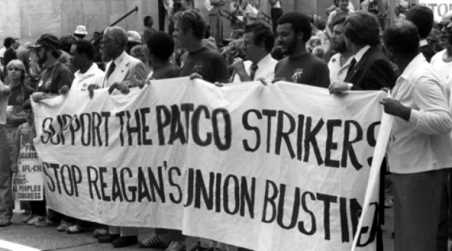
The early Reagan administration had to deal with many issues. One was when Air Traffic Controllers strike. Thousands of workers heroically protested. Reagan refused to negotiate with the Professional Air Traffic Controllers (PATCO). He fired the striking workers, since he said that the striking workers violated federal law. Like Dr. King has said, not all laws are just and opposing an unjust law is righteous. Social Security had rising costs during the 1980’s. So, Reagan supported the compromise of the Social Security Reform Act that increased the minimum retirement age and increased payroll taxes in order to fund Social Security. Conservatives promoted wanted vouchers to pay parents to send students into private schools, so competing against public school would grow. Liberals said that vouchers just stripped money from public schools. AIDS or the Acquired Immunodeficiency Syndrome first was discovered by mainstream scientists in 1981 (yet, AIDS existed long before 1980). It attacked tons of communities back then including the LGBTQIA+ community and drug users. Back then, many people had ignorance about HIV/AIDS and some scapegoated gay people for the disease. Reagan was silent on HIV/AIDS until later on in his Presidency (especially after Rock Hudson passed away).
George H. W. Bush’s President saw the massive rise of investments in fighting HIV/AIDS. In 1983, 241 U.S. Marines were killed by suicide bomb in Lebanon. This further exposed to America the reality of terrorism overseas. By 1984, the drug problem intensifies as crack (a smokable form of cocaine) is first introduced into the Los Angeles area. The crack epidemic and the War on Drugs harmed black and poor communities nationwide. In 1985, World awareness of famine in Third World countries spark "We Are the World" and Live Aid. Also, awareness of AIDS (acquired immune deficiency syndrome) is raised with the death of actor Rock Hudson. In the same year, Country music singer Willie Nelson and John Mellencamp organize the first Farm Aid concert to raise money for family farmers facing financial crisis.

The image on the right is from David Hume Kennerly/Getty.
1984
The 1984 election was long. It dealt with Ronald Reagan defeating the Democratic candidate Walter Mondale (and Geraldine Ferraro of New York as his running mate. Ferraro was the first woman to serve on either major party’s national ticket). The election dealt with the economy, foreign policy matters, and other issues. Reagan said that he had a strong economic recovery and a national revival of confidence and prestige. The problem is that income inequality grew and poverty was still widespread in many communities nationwide. Reagan used TV ads, speeches, and other methods in getting his victory. Mondale opposed Reagan’s supply-side economic policies and budget deficits. Walter Mondale wanted a nuclear freeze and ratification of the Equal Rights Amendment. By 1984, Ben Fernandez and Harold Stassen had a primary challenge against Reagan on the Republican side. Ronald Reagan won the Republican nomination easily with him getting over 98 percent of the popular vote. Reagan was re-nominated by a vote of 2,233 delegates (two delegates abstained). For the only time in American history, the vice presidential roll call was taken concurrently with the presidential roll call. Vice President George H. W. Bush was overwhelmingly re-nominated. This was the last time in the 20th century that the vice presidential candidate of either major party was nominated by roll call vote. The Democratic primary for the 1984 election was more competitive. Jesse Jackson ran for President in 1988 too. Other people who ran in the Democratic primary were Reubin Askew (former Governor of Florida), Alan Cranston, John Glenn, Gary Hart, Ernest Hollings, and George McGovern. The Democratic primary race was headed by votes among Mondale, Jackson, and Hart. Mondale raised more money. Jesse Jackson and Gary Hart had massive popularity too.
Jesse Jackson was the second African-American (after Shirley Chisholm) to mount a nationwide campaign for the presidency, and he was the first African-American candidate to be a serious contender. He got 3.5 million votes during the primaries, third behind Hart and Mondale. He won the primaries in Virginia, South Carolina, and Louisiana, and split Mississippi, where there were two separate contests for Democratic delegates. Through the primaries, Jackson helped confirm the black electorate's importance to the Democratic Party in the South at the time. Also, Jesse Jackson made a remark about Jewish people that he later apologized (since it was an anti-Semitic slur) and that event derailed his campaign for the nomination. If that incident didn’t exist, Jackson would win much more support. Jackson ended up winning 21% of the national primary vote but received only 8% of the delegates to the national convention, and he initially charged that his campaign was hurt by the same party rules that allowed Mondale to win. He also criticized Mondale, saying that Hubert Humphrey was the "last significant politician out of the St. Paul-Minneapolis" area. Gary Hart was a prelude to Bill Clinton. Hart wanted to promote moderate Democratic Party policies while condemning old fashioned New Deal (which saved millions of human lives. The New Deal is a whole lot better than Hart’s centrism). Mondale defeated Hart since he said that Hart had no specific positions to solve problems. At a roundtable debate between the three remaining Democratic candidates moderated by Phil Donahue, Mondale and Hart got into such a heated argument over the issue of U.S. policy in Central America that Jackson had to tap his water glass on the table to help get them to stop.

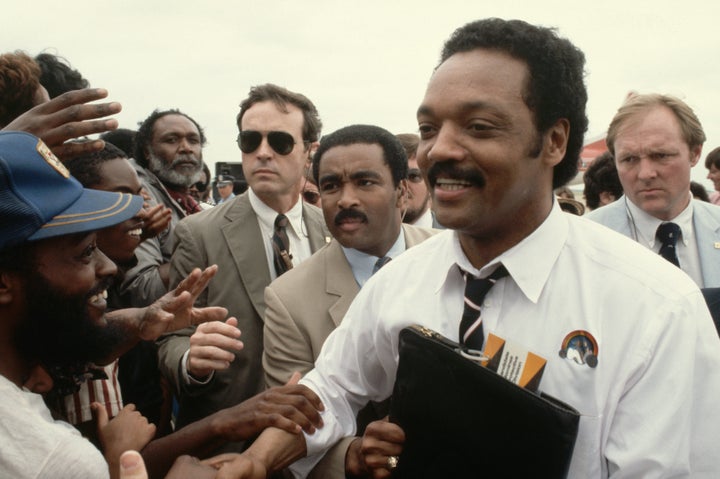
Jesse Jackson won many support among grassroots black people (including progressives and other minorities) while some black people supported Mondale because they believed that Jackson wouldn’t win or for other reasons. Hart won the California primary. By the time of the Democratic National Convention in San Francisco on July 16, Mondale received the overwhelming support of the unelected super delegates from the party establishment to win the nomination. This race for the Democratic Party presidential nomination was the closest in two generations, and, as of 2017, it was the last occasion that a major party's race for the presidential nomination went all the way to its convention. Jesse Jackson gave a stirring speech at the 1984 Democratic National Convention. It was a historic speech that called for unity among Americans like a rainbow to combat Reaganism. Also, Mondale said that he and Reagan will raise taxes. That was taboo since Presidents do raise taxes, but Presidents rarely said such things in a convention speech. U.S. Representative Geraldine A. Ferraro was the Vice Presidential running mate. Ferraro worked with New York Governor Mario Cuomo. Reagan had his campaign. John Anderson was running in the National Unity Party. The Citizens Party and the Libertarian Party plus the Communist Party (Angela Davis ran for President) ran their candidates. Mondale ran a liberal campaign by supporting a nuclear freeze, the Equal Rights Amendment (ERA), and economic solutions to the unfairness of Reagan’s economic policies. Critics came after Ferraro for her political views and allegations about her husband, John Zaccaro. The Reagan campaign briefly used "Born in the U.S.A.", a song criticizing the treatment of Vietnam War veterans (which they mistakenly thought was devoid of anti-war content), as a campaign song, without permission, until Springsteen, a lifelong Democrat, insisted that they stop. Some people questioned Reagan’s age while being President.
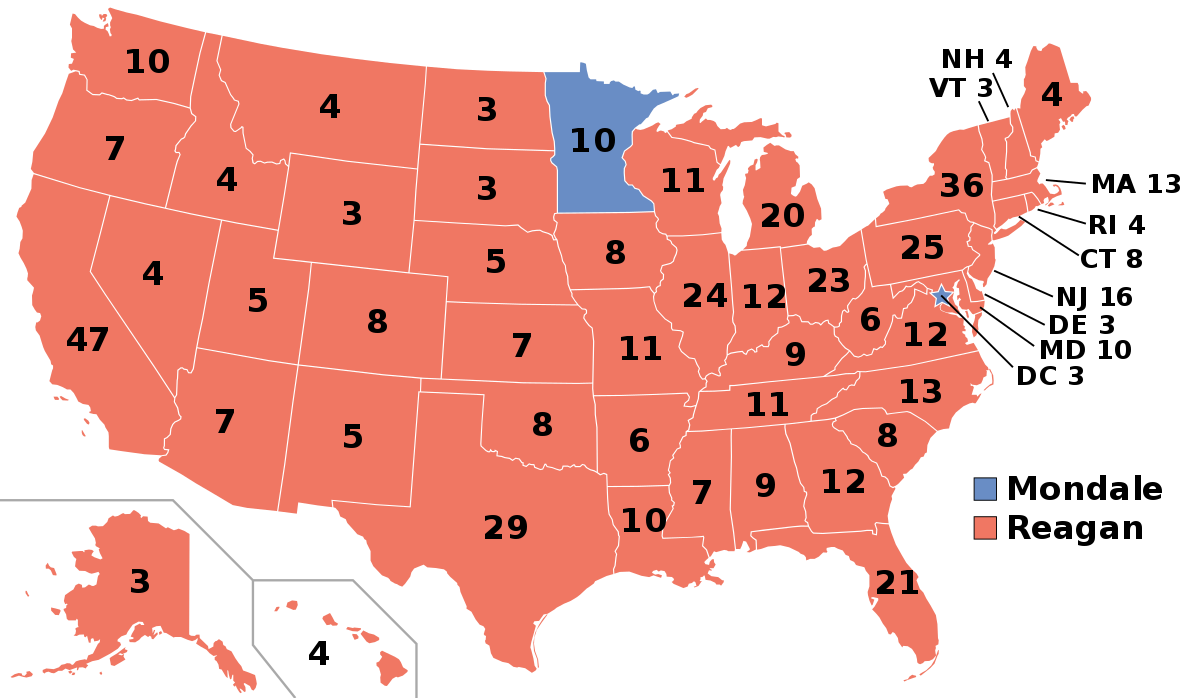
His second debate ended that issue by his comments. Ronald Reagan was re-elected in 1984 by November 6, 1984. Reagan won in a landslide. He won a record 525 electoral votes total (of 538 possible), and received 58.8% of the popular vote; despite Ferraro's selection, 55% of women who voted did so for Reagan, and his 54 to 61% of the Catholic vote was the highest for a Republican candidate in history. Mondale's 13 electoral college votes (from his home state of Minnesota—which he won by 0.18%—and the District of Columbia) marked the lowest total of any major presidential candidate since Alf Landon's 1936 loss to Franklin D. Roosevelt. Mondale's defeat was also the worst for any Democratic Party candidate in American history in the Electoral College. Reagan Democrats helped to send Reagan to the White House again. Many of them were made up of southern whites and northern blue collar workers. Some of them believed in scapegoating poor and minority people for the problems of the middle class. They believed that they had an economic recovery. Reagan lost Minnesota. By the second term of the Reagan administration, tax reform laws were passed and other events came about.

Cold War Developments
During the Reagan Presidency, the Cold War reached its zenith and it ended. Stalinism declined because of many reasons. The Soviet Union extended its military aid so much in Afghanistan and in other places that investments in domestic areas declined. Massive violations to civil liberties existed in the Soviet Union, and protests in many Soviet areas grew up the movement to end the Soviet Union. A combination of factors made it clear that the Soviet Union was dying. Yet, Ronald Reagan called the Soviet Union the evil empire and claimed that the Soviets were the biggest threats on Earth. Reagan massively expanded the U.S. military since he wanted to combat the perception that America lost its way militarily after the Vietnam War. He also wanted a military build up to combat the Soviets and end their existence. Reagan was overt in wanting the Soviet Union to end starting in Eastern Europe. He always condemned Communism in his speeches for decades. He supported covert actions to combat communism worldwide. So, Reagan sent billions of dollars to fund B-1 bombers, B-2 bombers, MX missile systems, and SDI (Strategic Defense Initiative using missiles to combat a nuclear attack). Reagan placed nuclear missiles in Europe which was protested worldwide as some wanted a nuclear freeze. Reagan aided anti-Communists in Afghanistan, Central America, etc. That is why Reagan backed the Contras. The problem with the Contras was that they were brutal, vicious, and authoritarian.
A right wing regime in El Salvador was funded by Reagan’s people as well. El Salvador had such of a bad human rights record that even Congress wanted funding to that nation dependent on its human rights record. In October 25, 1983, U.S. forces invaded Grenada to stop a left wing movement from governing the nation. The troops protected American medical students. There were controversial legal questions about the invasion (in seeing whether it was legal or not), but most Americans supported the decision to invade Grenada. By 1985, Mikhail Gorbachev was the President of the Soviet Union. Gorbachev was a more moderate Soviet leader and worked with Reagan to resolve Cold War issues. Gorbachev followed glasnost and perestroika in order to have a less state ruled economy. He wanted reforms since the Soviet Union was in economic chaos. Factories were down and workers suffered economic tribulations. Reagan moderated his stance on the Soviet Union. Both leaders talked about nuclear weapons in START I negotiations. Reagan wanted the Berlin Wall to come down in his famous 1987 speech in Germany. In 1987, the Intermediate-Range Nuclear Forces Treaty is signed in Washington, D.C. by President Reagan and Soviet Premier Gorbachev. Reagan and Gorbachev toasted each other in Moscow.

By the end of the 1980’s, Eastern Europe became free from Stalinism. Poland, Czechoslovakia, and Hungary had democratic elections. The Berlin Wall came down in 1989. Communism soon ended in Romania and Bulgaria by 1989. The beginning of the end of the Cold War was unexpected, quick, and it wasn’t bloodless though. Romania was a nation with massive bloodshed involving them leaving the Soviet Union. Poland had bloodshed too. It is no secret that the CIA and the Vatican worked together to promote the Solidarity movement in Poland in order for Communism to end in Poland. Stalinism is antithetical to socialism since Stalinism sought authoritarianism (i.e. workers were denied to collectively bargain, Stalin destroyed religious buildings, and Stalin murdered independent socialist leaders) at the expense of political and social freedoms. The Cold War finally over sent a new sense of change to people worldwide. The Cold War made it known that the emancipation of the working class and all oppressed people must be enacted. Challenger broke apart after launch in 1986, killing all crew on board. Drunk driving awareness raised after a drunk driver's car crashes into a church bus near Carrollton, Kentucky, killing 27 in 1988. 1988 was the year when Discovery launched as first post-Challenger Space Shuttle flight. In 1988, Intermediate-Range Nuclear Forces Treaty went into effect.


Scandals and Immigration Issues
Scandal has been a part of the lives of so many Presidents. Reagan is no exception. By the 1980’s, America clashed with Libya. Muammar al-Qaddafi was the leader of Libya back then. Reagan accused Qaddafi of backing terrorists worldwide. In 1986, there was a Berlin terrorist attack in a nightclub. Reagan blamed the attack on Qaddafi, so later U.S. warplanes bombed Libya. The air raid killed one of Qaddafi’s daughters. Qaddafi survived ,and his criticism of America decreased until the future (with the Libyan vs. NATO war by the 2010’s). Reagan was criticized in 1985 when he was accused of honoring Nazi war criminals at a cemetery in West Germany. Reagan by February of 1985 visited a Germany military cemetery in Bitburg and to place a wreath alongside West German Chancellor Helmut Kohl. Deaver was given assurances by a German head of protocol that no war criminals were buried there. It was later determined that the cemetery held the graves of 49 members of the Waffen-SS. What neither Deaver nor other administration officials initially realized was that many Germans drew a distinction between the regular SS, who typically were composed of Nazi true believers, and the Waffen-SS which were attached to military units and composed of conscripted soldiers. That is silly since both types of troops are still Nazis. As the controversy brewed in April 1985, Reagan issued a statement that called the Nazi soldiers buried in that cemetery as themselves "victims," a designation which ignited a stir over whether Reagan had equated the SS men to victims of the Holocaust. These Nazi soldiers were never victims. They were criminals period. The victims of the Holocaust are the actual victims. Strident conservative, Roman Catholic, and Knight of Malta Pat Buchanan (who is known to have made racist and anti-Semitic comments for decades), who was Reagan's Director of Communications, argued that the president did not equate the SS members with the actual Holocaust, but as victims of the ideology of Nazism. That is a bunch of nonsense since there were many Germans who resisted Nazi ideology.
Now strongly urged to cancel the visit, the president responded that it would be wrong to back down on a promise he had made to Chancellor Kohl. On May 5, 1985, President Reagan and Chancellor Kohl first visited the site of the former Nazi Bergen-Belsen concentration camp and then the Bitburg cemetery where, along with two military generals, they did place a wreath. One of the worst parts of the Reagan administration was their expansion of the War on Drugs. There was a crack epidemic in America. Reagan advanced law enforcement power to jail and imprison even nonviolent drug offenders. While Reagan wanted drug free zones, authoritarian policies followed. In 1986, Reagan signed a drug enforcement bill that budgeted $1.7 billion (equivalent to $3.9 billion in 2018) to fund the War on Drugs and specified a mandatory minimum penalty for drug offenses. Nancy said Just Say No in dealing with drugs. The mass incarceration state grew and militarized police occupied communities (both black and non-black neighborhoods alike).
The bill was criticized for promoting significant racial disparities in the prison population, and critics also charged that the policies did little to reduce the availability of drugs on the street, while resulting in a great financial burden for America. As the years came about, more people were imprisoned and adolescent drug use declined. Poor communities suffered. The problems with the War on Drugs are that it harmed civil liberties, it advanced injustices in the criminal justice system, and it lacked alternatives to help nonviolent people with drug addiction. The Iran Contra scandal was one of the biggest scandals of the 1980’s, and it almost ended the Reagan Presidency. The Iran Contra affair was about when the United States sold weapons to Iran in 1985. This was done in exchange for Iran’s promise to pressure a terrorist group in Lebanon to release some American hostages. The plan didn’t work. It was against the administration’s policy of refusing to negotiate with terrorists. Also, the Reagan administration used the money from the sale to fund the Contras in Nicaragua despite the fact that in 1983, Congress banned sending funds to the Contras. The Contras were known as far right authoritarians who brutalized people in Central America. In 1986, the deals came out to the public. President Ronald Reagan admitted responsibility for the actions of the administration, but he never admitted to directly ordering his aides to support the Contras. He opened his own investigation and appointed two Republicans and one Democrat, John Tower, Brent Scowcroft and Edmund Muskie, respectively, to investigate the scandal. The commission could not find direct evidence that Reagan had prior knowledge of the program, but criticized him heavily for his disengagement from managing his staff, making the diversion of funds possible. Iran Contra almost ended Reagan’s Presidency. Many leading administration officials and a top aide, Oliver North, were convicted on charges from the scandal. Many of the convictions were overturned on technical grounds. Still, Reagan left office with high approval ratings. Ronald Reagan signed the Immigration Reform and Control Act of 1986. It criminalized employers who knowingly hire or recruit undocumented immigrants while giving amnesty to about 3 million undocumented immigrants who came into the United States before January 1, 1982 and had lived in America continuously.

Upon signing the act at a ceremony held beside the newly refurbished Statue of Liberty, Reagan said, "The legalization provisions in this act will go far to improve the lives of a class of individuals who now must hide in the shadows, without access to many of the benefits of a free and open society. Very soon many of these men and women will be able to step into the sunlight and, ultimately, if they choose, they may become Americans." Reagan also said, "The employer sanctions program is the keystone and major element. It will remove the incentive for illegal immigration by eliminating the job opportunities which draw illegal aliens here." Obviously, the term of "illegal aliens" is inappropriate since undocumented immigrants is the proper name to call human beings who are undocumented here. The economic situation by the end of Reagan’s second term was great for the wealthy and upper middle class. Yet, the debt increased, the deficit grew, and income inequality flourished. The second term of Ronald Reagan started on January 20, 1985 when he was sworn into office for the second time. Staff members on his team were Chief of Staff James Baker, and Peggy Noonan. In his second term, Reagan elevated William Rehnquist to succeed Warren E. Burger as Chief Justice, and named Antonin Scalia to fill the vacant seat. Reagan nominated conservative jurist Robert Bork to the high court in 1987. Senator Ted Kennedy, a Democrat of Massachusetts, strongly condemned Bork, and great controversy ensued. Bork's nomination was rejected 58–42. Reagan then nominated Douglas Ginsburg, but Ginsburg withdrew his name from consideration after coming under fire for his cannabis use. Anthony Kennedy was eventually confirmed in his place. Along with his three Supreme Court appointments, Reagan appointed 83 judges to the United States courts of appeals, and 290 judges to the United States district courts.
Early in his tenure, Reagan appointed Clarence M. Pendleton Jr., of San Diego as the first African American to chair the United States Commission on Civil Rights. Pendleton tried to steer the commission into a conservative direction in line with Reagan's views on social and civil rights policy during his tenure from 1981 until his sudden death in 1988. Pendleton soon aroused the ire of many civil rights advocates and feminists when he ridiculed the comparable worth proposal as being "Looney Tunes.” Ronald Reagan’s legacy has been debated to this day. He gave a voice to many conservatives, and he was a formidable adversary towards progressive thinking. One part of Ronald Reagan's legacy would deal with economics. The real value of the minimum wage in inflation adjusted dollars declined in 44 percent between 1981 and 1989. 32 million Americans lived beneath the poverty line by the end of the Reagan Presidency. 31.6 percent of African Americans, 26.8 percent of Latinos, and 10.1 percent of white people lived in poverty by the end of his second term. Federal resources of minorities involving health care declined. The reactionary, cruel legacy of the Presidency of Reagan taught us that life shouldn't revolve around the rich alone. It revolves around the concerns of all of the people, and the government should have an active role in helping humanity.

President George H. W. Bush
As early as 1985, then Vice President George H. W. Bush planned to run for President in 1988. He came into the Republican primaries for President by October 1987. He had his challengers of U.S. Senator Bob Dole of Kansas, U.S. Representative Jack Kemp of New York, former Governor Pete du Pont of Delaware, and conservative Christian televangelist Pat Robertson. John Ashcroft was allied with George H. W. Bush too. Bush was considered the early front-runner for the nomination, but he came in third in the Iowa caucus, behind winner Dole and runner-up Robertson. Reagan reorganized his staff to try to win the New Hampshire primary later. Dole was ahead in New Hampshire. Then, Bush ran television commercials to portray Dole as a tax raiser. Bush then on the state’s primary. Following the primary, Bush and Dole had a joint media appearance; when the interviewer asked Dole if he had anything to say to Bush, Dole said, in response to the ads, "yeah, stop lying about my record!" in an angry tone. This is thought to have hurt Dole's campaign to Bush's benefit. Bush continued seeing victory, winning many Southern primaries as well. Once the multiple-state primaries such as Super Tuesday began, Bush's organizational strength and fundraising lead were impossible for the other candidates to match, and the nomination was his. George H. W. Bush decided to select U.S. Senator Dan Quayle of Indiana as his running mate. The Democratic Primary of 1988 had Jesse Jackson with a stronger campaign than in 1984. He won many working class voters including many states. Other Democratic candidates in the 1988 primary were Al Gore, Paul Simon, Joe Biden, Pat Schroeder, Gary Hart, Dick Gephardt, and other people. Jesse Jackson in his 1988 campaign won many state primaries. He appealed to black people, socialists, feminists, community activists, and other working class people. Yet, the Democratic Party established mistreated him. Back in those days, it was taboo for a progressive (especially a progressive black man) to run for office without apology. Dukakis refused to select him as his running mate, but he picked the conservative Democrat Senator and Freemason Lloyd Bentsen. Back then, Bush was trailing Democratic nominee Michael Dukakis (then Governor of Massachusetts) in most polls.
Bush wasn’t as eloquent as Ronald Reagan, but he gave his famous thousand points of light speech at the 1988 Republican National Convention. Back in 1988, George H. W. Bush appealed to apple pie stereotypical themes. He wanted to promote the Pledge of Allegiance, capital punishment, gun rights, and prayer in schools plus he opposed abortion. He is famous for saying the famous pledge: “Read my lips: no new taxes." The campaign among Bush and Dukakis are harsh and dirty. Dukakis didn't campaign much in the African American community until late in his campaign. Jackson's constituents were ignored by Dukakis. Then and now, some people would rather vote against their economic interests for a conservative than a progressive. Bush accused Dukakis of polluting the Boston Harbor as governor of Massachusetts. Dukakis didn’t agree with a law requiring all students to say the Pledge of Allegiance. Dukakis opposed the death penalty even if his wife was raped. Back then, that was very controversial. Bush said that Dukakis was soft on crime. Bentsen's retort to Vice President Dan Quayle during the 1988 vice presidential debate, "You're no Jack Kennedy," has entered the lexicon as a widely used phrase to deflate politicians who are perceived as thinking too highly of themselves. The Bush campaign showed the infamous, racist Willie Horton aid. Dukakis’s running mate Lloyd Bentsen would late become on architect of President Bill Clinton's economic policies. Bush won the 1988 election with 426 to 111 in the Electoral College.

In the nationwide popular vote, Bush took 53.4% of the ballots cast while Dukakis received 45.6%. Bush became the first serving vice president to be elected president since Martin Van Buren in 1836, as well as the first person to succeed someone from his own party to the presidency via election to the office in his own right since Herbert Hoover in 1929. George H. W. Bush was inaugurated on January 20, 1989. He saw many changes including the end of the Cold War. He had to deal with high deficits. Bush wanted to cut down the deficit with a balanced budget proposal. He began an effort to persuade the Democratic controlled Congress to act on the budget. Republicans believed that the best way was to cut government spending, and Democrats convinced that the only way would be to raise taxes. So, Bush faced problems when it came to consensus building. Later, Bush was forced by a Democratic majority to raise tax revenues. Many Republicans felt betrayed as he gave his “no new taxes” speech in 1988. Perceiving a means of revenge, Republican congressmen defeated Bush's proposal, which would enact spending cuts and tax increases that would reduce the deficit by $500 billion over five years. Scrambling, Bush accepted the Democrats' demands for higher taxes and more spending, which alienated him from Republicans and gave way to a sharp decrease in popularity. Bush later said that he wished that he had never signed the bill. Near the end of the 101st Congress, the president and congressional members reached a compromise on a budget package that increased the marginal tax rate and phased out exemptions for high-income taxpayers. Although he originally demanded a reduction in the capital gains tax, Bush relented on this issue as well. This agreement with the Democratic leadership in Congress proved to be a turning point in the Bush presidency; his popularity among Republicans never fully recovered. About the time of the budget deal, America experienced a recession lasting six months. Unemployment grew and more people had to get on welfare. Unemployment was very high by 1991.


Bush gave unemployed workers more benefits. By his second year in office, Bush was told by his economic advisors to stop dealing with the economy, as they believed that he had done everything necessary to ensure his reelection. By 1992, interest and inflation rates were the lowest in years, but by midyear the unemployment rate reached 7.8%, the highest since 1984. In September 1992, the Census Bureau reported that 14.2% of all Americans lived in poverty. There was the Savings and Loan crisis of 1989 as well. This was about 1,000 Savings and Loan banks failing. Some of this was because some banks used bad behavior like promoting risky loans. Some believed that Reagan’s deregulation policies for encouraging banks to invest in riskier actions. The federal government spent up to $200 billion to bail out depositors at the failed banks. At a press conference in 1990, Bush told reporters that he found foreign policy more enjoyable.
The truth is that you have to deal with both domestic and foreign policy matters. He proposed the Educational Excellence Act of 1989 to advance educational reform. He wanted public and private involvement in improving education. On July 23, 1992, Bush signed the Higher Education Amendments of 1992, a resumption of "many programs in the Higher Education Act of 1965." George H. W. Bush wanted to promote a more moderate image than Reagan despite his controversies. That is why he praised Nelson Mandela, invested in HBCUs, appointed African Americans in his cabinet, and increased the budget of the Equal Employment Opportunity Commission (which fights workplace discrimination). Bush praised Dr. Martin Luther King Jr. while ignoring his condemnation of the Vietnam War, domestic poverty, and capitalism. Bush made the mistake of trying to get William Lucas to be head of the justice Department's civil rights division when he had lax experience (and he was very malleable to police brutality incidents against black people when he was Wayne Couty sheriff in Michigan). George H. W. Bush loved to support black neoconservatives not black progressives.


Also, it is important that issues of race were abundantly debated during the 1980's. There is no question that massive hate crimes existed during the 1980's and the early 1990's (plus beyond). By the 1980's, new feminist black scholars promoted solutions like Angela Davis and Bell Hooks. They realize that race, class, gender, and other factors must be discussed openly if we are to transform society in order to see the emancipation of women. A police shooting of a black man and a long system of racial oppression in Miami inspired the 1980 Miami rebellion. During the 1980's, many colleges (like Smith, Brown, and Colby) saw the harassment of black students involving racist graffiti, violence, and intimidation. These racist incidents didn't just occur in the South. Violence and racist attacks against black people existed in the North, including in New York City. On October 29, 1984, 66-year-old Eleanor Bumpurs was shot and killed by police as they tried to evict her from her Bronx apartment. Bumpurs, who was mentally ill, was wielding a knife and had slashed one of the officers. The shooting provoked heated debate about police racism and brutality. In 1987, officer Stephen Sullivan was acquitted on charges of manslaughter and criminally negligent homicide stemming from the shooting. In 1986, a white mob in Howard Beach, Queens, attacks three African-American men whose car had broken down in the largely white neighborhood. One of the men, Michael Griffith is chased onto Shore Parkway where he is hit and killed by a passing car. The killing prompted several important marches through the neighborhood led by Al Sharpton. On August 23, 1989, Yusuf Hawkins was murdered by white racists in Bensonhurst, a predominantly Italian-American working-class neighborhood in the New York City borough of Brooklyn. Hawkins and three friends were attacked by a crowd of 10 to 30 white youths, with at least seven of them wielding baseball bats. One, armed with a handgun, shot Hawkins twice in the chest, killing him. Shortly before that march was set to begin on January 12, 1991, Al Sharpton was stabbed and seriously wounded by Michael Riccardi in a Bensonhurst schoolyard. Sharpton later recovered from his wounds. So, the 1980's was a very serious decade. Also, many great activists fighting for justice existed during that time too.

President George H. W. Bush promoted the reunification of Germany. He signed major bills like the Americans with Disabilities Act of 1990; this was one of the most pro-civil rights bills in decades. He was also the only president to successfully veto a civil rights act, the job-discrimination protection Civil Rights Act of 1990. He baited that bill as promoting “racial quotas” and signed a watered down Civil Rights Act of 1991. He worked to increase federal spending for education, childcare, and advanced technology research. He also signed the Radiation Exposure Compensation Act, which provides monetary compensation of people who had contracted cancer and a number of other specified diseases as a direct result of their exposure to atmospheric nuclear weapons testing undertaken by the United States during the Cold War. He reauthorized the Clean Air Act to require cleaner burning fuels. He signed a bill to aid police work. He signed a law in growing the nation’s high way system. He signed the Immigration Act of 1990 that increased legal immigration into America by 40 percent. On November 21, 1989, Bush signed a measure that guaranteed reparations to Japanese-Americans who were relocated into internment camps during World War II. Congress authorized US$20,000 (equivalent to $40,424 in 2018) for each survivor. Bush was a member of the NRA and signed a temporary ban on the import of some semiautomatic rifles. Bush resigned after some NRA people called agents of the Bureau of Alcohol, Tobacco, and Firearms as “jack-booted thugs.” He called the NRA letter a "vicious slander on good people." He promoted volunteerism in his Points of Light movement. One of his most controversial acts was appointing Clarence Thomas (who was accused of sexual harassment by Anita Hill and other women) to the Supreme Court in 1991. He appointed David Souter in 1990. Bush removed Noriega from power after he was accused of spying for Fidel Castro and for Noriega drug trafficking to America. 24,000 U.S. troops were sent to Panama to end Noriega’s rule. This act was controversial. Endara assumed the President and Noriega was imprisoned.

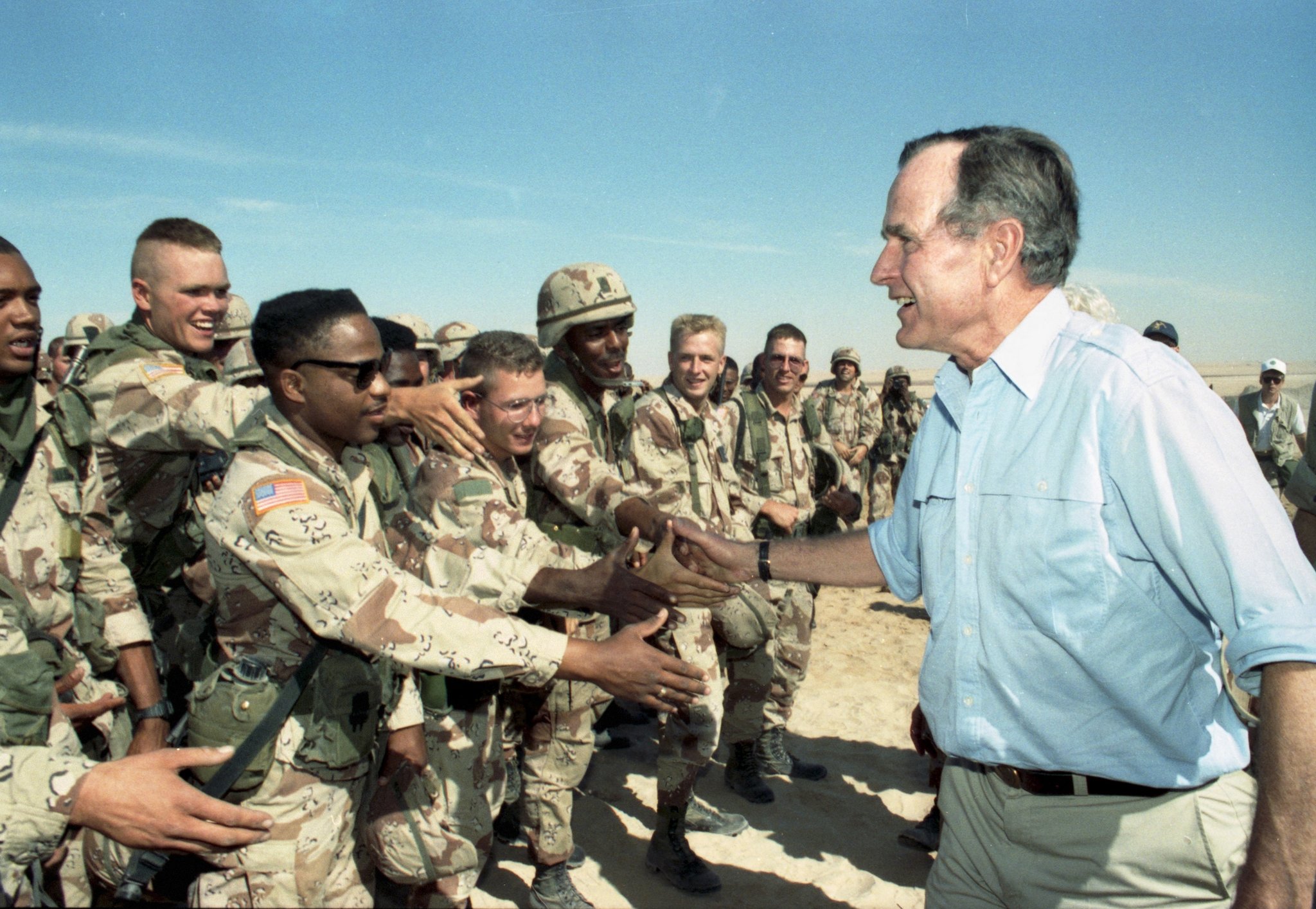
The Persian Gulf War
The Persian Gulf War lasted for a short period of time, but its impact existed for years and decades. It existed in phases. On August 2, 1990 invaded the oil rich nation of Kuwait. Saddam thought that Kuwait belonged to Iraq. Saddam was once an ally of America as America plus other Western nations funded Iraq during the 1980’s. Bush was concerned that Saddam could possibly invade Saudi Arabia. This could harm the economy, so Bush wanted to act. Bush condemned Saddam’s invasion and rallied an opposition to Saddam’s action among European, Asian, and Middle Eastern allies. Secretary of Defense Dick Cheney traveled to Saudi Arabia to meet with King Fahd, who requested United States military aid in the matter, fearing a possible invasion of his country as well. The request was met initially with Air Force fighter jets. Iraq made attempts to negotiate a deal that would have allowed the country to take control of half of Kuwait. Bush rejected this proposal and insisted on a complete withdrawal of Iraqi forces. President George H. W. Bush allowed General Norman Schwarzkopf Jr. to led ground operation forces in the U.S.-led coalition to invade Iraqi forces.
Bush went into Congress to try to get Congressional authorization of air and land attacks. His objections were the following: "Iraq must withdraw from Kuwait completely, immediately, and without condition. Kuwait's legitimate government must be restored. The security and stability of the Persian Gulf must be assured. And American citizens abroad must be protected." He then outlined a fifth, long-term objective: "Out of these troubled times, our fifth objective — a new world order — can emerge: a new era — freer from the threat of terror, stronger in the pursuit of justice, and more secure in the quest for peace. An era in which the nations of the world, East and West, North and South, can prosper and live in harmony ... A world where the rule of law supplants the rule of the jungle. A world in which nations recognize the shared responsibility for freedom and justice. A world where the strong respect the rights of the weak." With the United Nations Security Council opposed to Iraq's violence, Congress authorized the use of military force with a set goal of returning control of Kuwait to the Kuwaiti government, and protecting America's interests abroad.
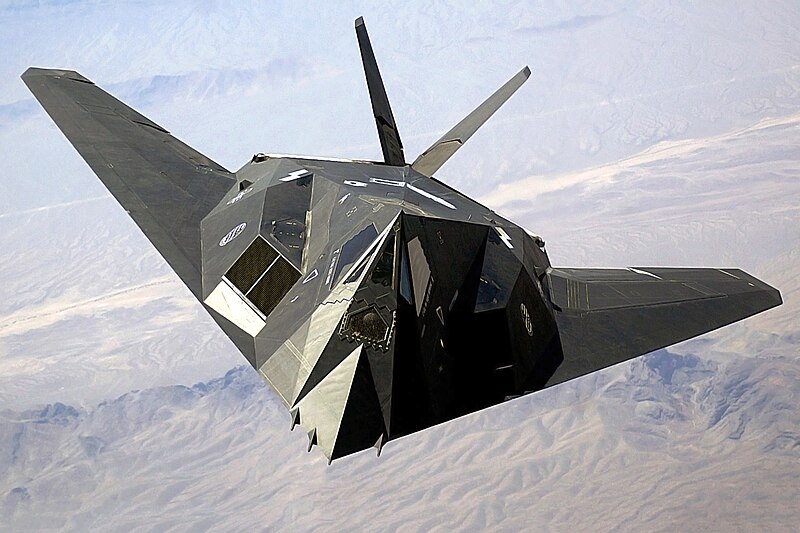
On the morning of January 17, 1991, the Allied forces launched the attack. It involved more than 4,000 bombing runs by coalition aircraft. This pace would last for the next four weeks. The ground invasion occurred on February 24, 1991. Allied forces penetrated Iraqi lines and pushed toward Kuwait City, while on the west side of the country, forces were intercepting the retreating Iraqi army. Bush made the decision to stop the offensive after a mere 100 hours. Critics labeled this decision premature, as hundreds of Iraqi forces were able to escape; Bush responded by saying that he wanted to minimize U.S. casualties. Opponents further charged that Bush should have continued the attack, pushing Hussein's army back to Baghdad, then removing him from power. Bush explained that he did not give the order to overthrow the Iraqi government because it would have "incurred incalculable human and political costs... We would have been forced to occupy Baghdad and, in effect, rule Iraq." That prediction would be fulfilled during the future 2003 Iraqi invasion. The Persian Gulf War was an American victory. Bush’s approval ratings went into huge levels upwards. Additionally, President Bush and Secretary of State Baker felt the coalition victory had increased U.S. prestige abroad and believed there was a window of opportunity to use the political capital generated by the coalition victory to revitalize the Arab-Israeli peace process. The administration immediately returned to Arab-Israeli peacemaking following the end of the Gulf War; this resulted in the Madrid Conference, later in 1991. Several Iraqi families living in Belgium who lost loved ones in the Gulf War launched a lawsuit against George H. W. Bush for committing what they claim are war crimes in the 1991 Amiriyah shelter bombing in Baghdad, which killed more than 400 civilians. The suit was brought under Belgium's universal jurisdiction guarantees in March 2003. According to the Human Rights Watch, the Amiriyah shelter bombing was "a serious violation of the laws of war." President George H. W. Bush promoted his new world order. The political establishment of Republicans and Democrats during the late 1980's and early 1990's saw a rightward trend. After the Cold War ended, George H. W. Bush's new world order vision would be met with controversies and tests.
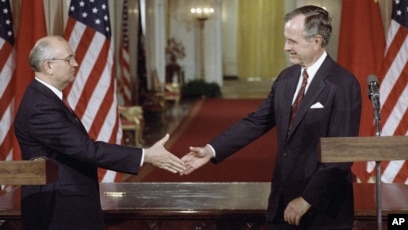
The End of the Cold War
The end of the Cold War ended in a serious of surprising events. By the early 1990’s, President George H.W. Bush and Mikhail Gorbachev had cordial conversations about foreign policy. Bush had experience in foreign policy as being an ambassador before he was President. In August of 1991, many Communists wanted to promote a coup to get rid of Gorbachev from power. They viewed Gorbachev as too moderate. Millions of Russians, led by the capitalist Boris Yeltsin, defended Gorbachev and stopped the coup from taking place. Soon, the Communist Party lost power. The Soviet Union separated into 15 independent republics. By the end of 1991, the Soviet flag came down and the Russian flag came up. It was the end of the Soviet Union and the birth of the Russian republic. Boris Yeltsin became the new leader of the Russian Federation. Russia was the largest nation of the now created independent republics. Yeltsin's neoliberal capitalist policies caused Russia to have economic problems during the 1990's. Gorbachev’s policy of glasnost inspired many European people to rebel against Soviet control.
The policy of perestroika challenged communist rule in the Soviet Union too. The Cold War never ended by one person alone. It ended by many factors. Reagan and Gorbachev contributed to the end of the Cold War. Yet, ultimately the economic and political problems found in the Soviet Union caused the Soviet Union to collapse. The Soviet Union ended from within. To many Americans, this was a miracle. Many Americans lived their whole lives in the Cold War and now, America was the sole superpower on Earth. George H. W. Bush signed agreements with Gorbachev and then with Boris Yeltsin. Both sides agreed to eliminate certain nuclear weapons, and Bush plus Yeltsin issued a joint statement in 1992 to pledge friendship including cooperation. The Cold War ended, but world problems never ceased to exist. Global problems after the Cold War became more regional and more complexities about international affairs persisted.
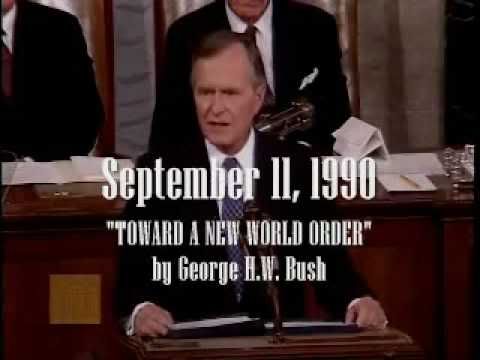
The New World Order?
For a long time, people have advocated a new world order. Mikhail Gorbachev promoted the new world order concept via his December 7, 1988 speech to the United Nations General Assembly. We do know many people want global government like the late Walter Cronkite. For the record, I don't believe in the creation of a global government. The new world order in general is about the expansion of globalization and governance in an international framework. On September 11, 1990, President George H. W. Bush gave his famous “Toward a New World Order” speech to a joint session of Congress. This speech was never ambiguous. It was overt in what he wanted. Bush’s new world order vision wanted: to promote U.S. strength, cooperation among the Gorbachev plus Americans, the First World controlling the affairs of the Third Word, Soviet integration into world economies, and a bipolar powerbase of America and the United Nations (America acting as a global policeman and the United Nations being a global judge and jury).
His speech was very much a blueprint of neoliberalism (George H. W. Bush graduated from Yale, was a Skulls and Bones member, he was part of the Navy during World War II, and he was the Director of the CIA. So, he was a member of the establishment). It was basically George H. W. Bush’s view that the United States of America must act as the unipolar force in the world as a superpower. The era of the end of the Cold War and post-Cold War era presented new challenges in the world stage too. In Latin America, many nations embraced democracy. Costa Rican leader Oscar Arias accepted a peace plan. There was the end of the civil war in El Salvador. Chile had the military dictator Augusto Pinochet giving up power. Bush allowed the capture and arrested of many drug traffickers like Eduardo Martinez Romero (he was part of the Columbian drug trade). George H. W. Bush supported the War on Drugs, and we know how the War on Drugs was executed in such a reactionary way that it harmed communities nationwide in America, especially the black community. By the Spring of 1989, there were Chinese students staging pro-democracy protests at Tiananmen Square in the heart of Beijing. The students wanted to end the government in China to be replaced. On June 1, 1989, Chinese tanks came into Beijing. These tanks killed hundreds of protesters, ended the demonstration, and imprisoned many pro-democracy activists.
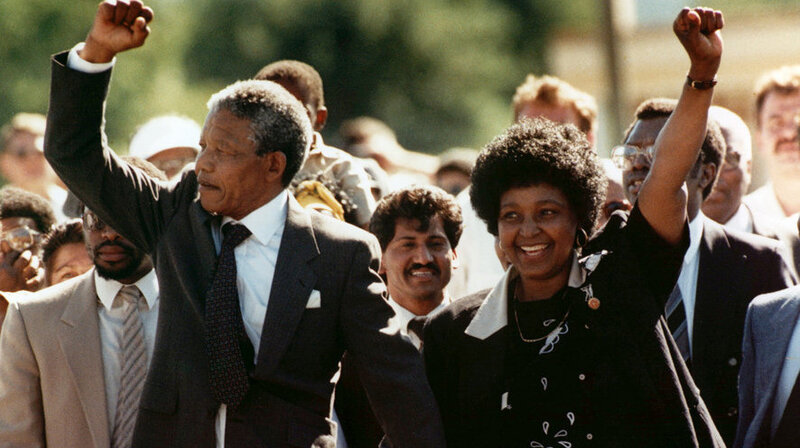
George H. W. Bush condemned the action and ended arms sales in China. Yet, he didn’t want harsher penalties against China. He wanted more economic and diplomatic ties instead of cutting off China completely. During this era, the end of apartheid in South Africa started to end. The South African government was controlled by racist whites who enacted a brutal apartheid system that exploited, harmed, and murdered black South Africans. Apartheid is a form of rigid segregation. The anti-apartheid movement was global by the 1980’s, and protests against apartheid grew worldwide. Many protesters divested money from South Africa. Some Western firms did the same. Congress imposed economic sanctions against South Africa instead of full divestment. Nelson Mandela (one major leader of the apartheid movement) was released from jail in 1990. He was in jail since 1962. President George H. W. Bush met with Nelson Mandela after he left jail. Bush endorsed bringing democracy in South Africa.
It is also important to acknowledge many Brothers and Sisters who helped to defeat apartheid like Steve Biko and other human beings. Apartheid was soon gone by the early 1990’s and Nelson Mandela was the first black South African President in 1994 after free elections. After the Cold War ended, Yugoslavia split apart into civil war (based on land, religion, and resources). Bush didn’t want to send troops there since he believed that it could be another Vietnam. He promoted a peace plan in Bosnia in 1992. New republics were carved out of Yugoslavia after more than 150,000 civilians died. George H. W. Bush also intervened in Somalia. He wanted to use humanitarianism as part of Operation Restore Hope. American Marines came into Somalia on December of 1992. They helped to form a cease fire among rival warlords and deliver foods to thousands of starving people. This mission reinforced UN efforts at peacekeeping. Many Somalians received relief. This act was praised by many quarters. As the early 1990’s existed, President George H. W. Bush would experience a series of events that caused his Presidency to end and create a new Presidency for a moderate from the state of Arkansas.


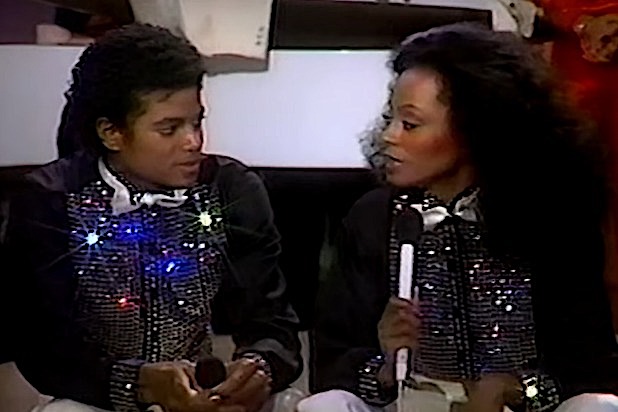

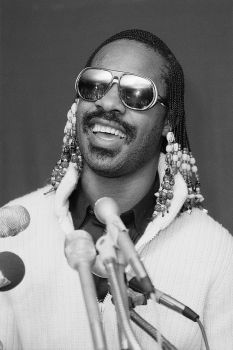
Appendix A: The Music and the Culture of the 1980’s
The music of the 1980’s was some of the most diverse, creative, and exciting displays of music not only in the 20th century but in the history of world. Every genre of music during the 1980’s was in top form from hip hop to gospel. Artists expressed themselves and new artists reached into new heights of popularity. The major themes of 1980’s music were the growth of dance music, new wave, pop music, and the quiet storm. Music and fashion combined as many musicians wanted to have the best music possible and display the most eclectic fashion possible at the same time. Rock music grew in diversity and harmonics plus synthesizers were commonplace. Eurodance, house, techno, electric were invented. Hip hop and R&B also exploded in popularity. Hip hop’s golden age originated in the 1980’s. Pop music became more international with artists like Michael Jackson, Prince, Madonna, etc. Michael Jackson’s Thriller album was the bestselling album in history. Whitney Houston was one of the most successful artists not only in the 1980’s but of all time. Whitney Houston had a one in a lifetime voice. This decade wasn’t without controversy. Back in the day, MTV refused to show music videos from black artists because they wanted a rock only policy and because of racist reasons. It took protests and criticism for MTV to allow videos from Michael Jackson, Donna Summer, and other black musicians to show their music videos on that network. Donna Summer’s song She Works Hard for the Money was an anthem. Madonna had songs like Like a Virgin and Like a Prayer.
Whitney Houston’s debut album of “Whitney” took everyone’s breath away with her amazing talent. Back in the 1980's, Whitney Houston toured the world and inspired future generation of artists. Phyllis Linda Hyman (July 6, 1949 – June 30, 1995) was a singer with an amazing voice too, and she was conscious to promote the freedom of black people. Paula Abdul hit it big in 1988 with the album Forever Your Girl. Janet Jackson, Tina Turner, Lionel Richie, and Diana Ross, and other artists expanded their legacies into new heights. Another teen pop wave of music grown by the early to late 1980’s with artists like New Edition, Stacey Q, Debbie Gibson, the Bangles, George Michael, Boy George, New Kids on the Block, Expose, Laura Branigan, etc. Prince was full of energy during this decade too. Chaka Khan won awards during the 1980’s. Classic songs came from Melissa Morgan, Sinead O’Connor, and Bruce Springsteen expanded boundaries with their songs. Another British explosion of artists came on the scene during the 1980’s like David Bowie, Phil Collins, John Lennon, Billy Ocean, Paul McCartney, and Sheena Easten. Groups like Culture Club, Duran Durban, Wham!, The Human League, the Police, etc. were popular. From the Pointer Sisters, Kool and the Gang, Kenny Rogers, and John Mellencamp, the diversity of 1980’s music was incredible. Rock music split into many genres from soft rock, hard rock, glam metal, etc. Alternative rock grew because of independent record labels and artists finding their own way. Groups like REM, etc. spread independent rock. U2 is a rock group from Ireland that still sell music since the 1980's and their messages resonate to this day. Independent artists like Tracy Chapman exposed the evils of poverty and discrimination going on in everyday life.



Rhythm and blues music had artists like Jermaine Jackson, James Ingram, the S.O.S. Band, Stevie Wonder, Smokey Robinson, Jeffery Osborne, Evelyn King, Marvin Gaye, the Jets, DeBarge, Midnight Star, Stephanie Mills, Jody Watley, and I can go down the list. The quiet storm genre included people like Anita Baker, Teddy Pendergrass, Peabo Bryson, Sade, and other people. By the late 1980’s, Teddy Riley invented new jack swing that merge hip hop and R&B influences together. This was in embraced by Bobby Brown, Keith Sweat, MC Hammer, Guy, etc. Hip Hop branched out by the 1980’s. Whodini, Sugarhill Gang, Doug E. Fresh, Biz Markie, the Furious Five, Grandmaster Flash, Melle Mel came about to show rhymes that moved the crowds. Turntables, graffiti, and rhyming flourished. Melle Mel and Duke Boote’s “The Message” was social conscious and it was hardcore. By the mid to late 1980’s, hip hop had more conscious content, more adult language, and a more complex lyricism with artists like Big Daddy Kane, MC Lyte, EPMD, Salt N Pepa, Ice T, Schooly D, Slick Rick, NWA, and other artists. Dance music and country music dominated the charts too. From heavy metal to pop, the music of the 1980’s had a smorgasbord of talent. Back then, you had to have talent to get into the door.
The culture of the 1980’s was diverse too. TV shows became more about the lives of ordinary people not just the rich. Steve Jobs and Bill Gates expanded the computer industry by hard work and collaborations. 1981 was the year when the IBM personal computer was released. The 1980’s had a high volume of consumerism and unfortunately materialism. More people relied on credit cards to buy items. Back in the day, very few people relied on credit cards for buying everything. Since the 1980’s, people use credit cards to buy items constantly. Atari, Nintendo, and Genesis flourished during the 1980’s. Worldwide, technological advances existed while income inequality grew. This time saw many nations embrace neoliberalism or laissez faire capitalism. Many multinational corporations (that deals with the manufacturing industry) relocated to Thailand, Mexico, South Korea, Taiwan, China, and other places. Gene therapy was invented. Studio films dominated the 1980’s like Ordinary People (1980), Chariots of Fire (1981), Gandhi (1982), Terms of Endearment (1983), Amadeus (1984), Out of Africa (1985), Platoon (1986), The Last Emperor (1987), Rain Man (1988), and Driving Miss Daisy (1989). One of the most well known films was the Color Purple which starred Whoopi Goldberg, Danny Glover, and Oprah Winfrey. It was released in 1985 and described life among African Americans in the Deep South. It showed taboos of early 20th century America on the issues of: domestic violence, incest, pedophilia, poverty, racism, and sexism. Celie is transformed as she finds her self-worth through the help of two strong female companions. It was directed by Steven Spielberg. ET, Return of the Jedi, Indiana Jones and the Last Crusade, Batman, Rain Man, Top Gun, and Beverly Hills Cops sold tons of money. Teenager movies were common.
Many films and television shows propelled the careers of modern celebrities such as Phylicia Rashad, Arnold Schwarzenegger, Bruce Willis, Margaret Avery, Debbie Allen, Eddie Murphy, Mel Gibson, Sylvester Stallone and Chuck Norris to international recognition. On the other side of the globe, Hong Kong action cinema was being revolutionized by a new wave of inventive filmmakers that includes Jackie Chan, Tsui Hark, and John Woo. Involving television, BET was born in the 1980’s. It was the first network whose shows were geared to black people. It continues to this day. BET or Black Entertainment Television in 2019 has a large comeback with movies and documentaries dealing with Soul Train, New Edition, criminal justice issues, and other topics. MTV expanded music videos as well. The 1980’s in many cases carried over many shows from the 1970’s like the Jeffersons, and Happy Days. Also, new shows were born during the 1980's like Matlock, 227, Murder She Wrote, the Cosby Show, Designing Women, Roseanne, Full House, Family Matters, The Simpsons, Amen, Head of the Class, Quantum Leap, etc. The 1980’s saw a transformation of television too. The 1980’s brought cable television into the forefront of viewership.


Shows like HBO and Showtime including ESPN brought in tons of new viewers. Satellite services allowed people in rural areas to have access to cable television. The 1980's also saw the debut of prime-time soap operas such as Dallas, its spin-off Knots Landing, Dynasty, Falcon Crest, EastEnders and Neighbours. Phil Donahue, Geraldo, Johnny Carson, Arsenio Hall, and David Letterman had their own talk shows. The Oprah Winfrey Show started in the 1980’s and she expanded her wealth into a billion dollar empire (with the OWN Network, etc.).
In terms of sports, Americans won many games in the 1984 Olympics. Also, the 1980’s saw Michael Jordan in the NBA to make records and amaze crowds. Michael Jordan came into the NBA by 1984 and the NBA would never be the same again. Magic Johnson, Kareem Abdul Jabbar, Dr. J, Larry Bird, and other athletes won championships during the 1980’s. Michael Jordan contributed to an increase of the popularity of basketball in the United States and worldwide. On November 26, 1986, Mike Tyson became the youngest boxing Heavyweight Champion in history at age 20. In the NFL, the San Francisco 49ers became the dynasty of the decade, winning four Super Bowls under the leadership of Joe Montana; the Chicago Bears won Super Bowl XX in January 1986, in which the team has been widely remembered for their defense; the Washington football team also enjoyed success throughout the decade, winning two of their three Super Bowls under the leadership of head coach Joe Gibbs. Magic Johnson and Larry Bird became the two most popular NBA players during the decade while even facing against each other in three NBA Finals (1984, 1985, and 1987) continuing the storied Celtics-Lakers rivalry. Jackie Joyner Kersee won track and field awards during the 1980's and beyond. Jackie Joyner Kersee is one of the greatest athletes in human history. Flo Jo won Olympic medals too in the 1984 and 1988 Olympic Games in Los Angeles and Seoul respectively. Flo Jo was the greatest woman sprinter in history. As for hair, there were the perm, the mullet, the Jheri curl, the hi-top fade, and big hair in the 1980’s. The 1980’s saw shoulder pads, jean jackets, leather pants, etc. The Rubik’s cube has been defined as a 1980’s cultural icon. The 1980’s was the decade of my birth as I was born in 1983. I remember the 1980’s as a child in elementary school, and it’s a decade with a lot of dynamic power and creative energy.
By Timothy
No comments:
Post a Comment